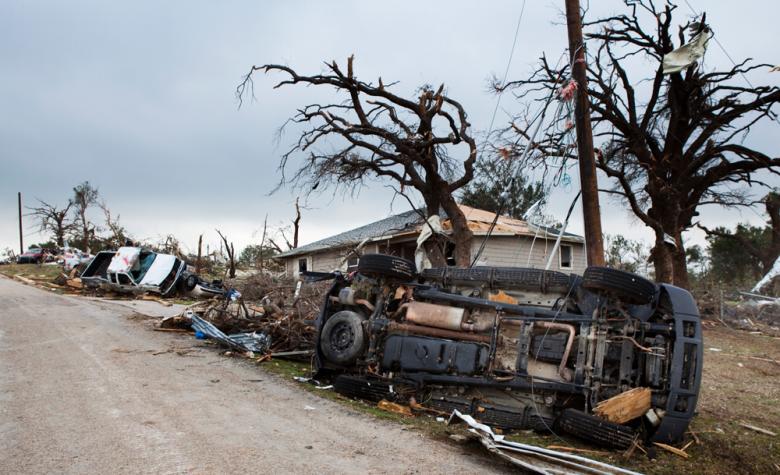Before and after the Granbury tornado: The resilience of Rancho Brazos
At dinnertime on May 15, 2013, an EF-4 tornado with winds of up to 200 miles per hour ripped through the north Texas town of Granbury.
All 60 of the homes built in the Rancho Brazos neighborhood by Habitat for Humanity of Hood County were damaged, more than a dozen completely destroyed.
Two years later, those homes have been rebuilt, and 19 additional families now call this Habitat neighborhood home. Take a look at these before-and-after photos and celebrate the hope that is possible when we all come together to build — and rebuild.
Learn more about Habitat’s disaster response work and donate today.
1
/
3

The Hill family was home when the tornado destroyed their Habitat house in the Rancho Brazos neighborhood. Thankfully, no one was hurt.

To speed up recovery efforts, Habitat Hood County worked with mom Trica Hill and other shell-shocked families to file claims for homeowners insurance and to line up volunteers and private contractors to rebuild their houses.

A pristine, thriving patch of grass now stands in stark contrast to a child’s sneaker and other items flung far and wide during the tornado. Immediately following the disaster, volunteers came from all over the country to clean up debris in the Texas.

“Some volunteers we knew, some we didn’t, and some we may never see again,” Davidson says. “They came and took care of tasks that seemed insurmountable in our eyes.”

The tornado destroyed a warehouse belonging to Habitat Hood County. The only piece of equipment not damaged was a tractor. The small, all-volunteer local Habitat decided to rebuild the warehouse as a symbol of its commitment to the community.

“It was important to send a message to the neighborhood that we are not going anywhere,” Davidson says.

The tornado blew away the mobile home at one corner of Tumbleweed Lane and Sagecrest Court, ripping Jerry Shuttlesworth and his dog Junior from the laundry room where they sought cover.

Several days later, a badly injured Shuttlesworth was reunited with his dog, which turned up at a local animal shelter. Today, the two and Shuttleworth’s father live in a new Habitat house built on the same lot.

At 3 p.m. the day the tornado hit, Habitat Hood County volunteers had completed the finishing touches on a home belonging to Olga Hernandez. Four hours later, the house had been wiped from its slab.

Volunteers and staff from Trinity Habitat in nearby Fort Worth, Texas, helped the Hernandezes rebuild.

Immediately following the tornado, an American flag lofted in a leaf-stripped tree became a symbol of resilience for the Rancho Brazos neighborhood.

The trees, like the neighborhood, are making a comeback. “We celebrate every leaf on them,” says Habitat Hood county executive director Davidson.

Habitat partner family Antonio and Irma Mojica survived the tornado by seeking shelter in the bathroom.

The Mojicas have since rebuilt. “I never felt defeated,” Antonio says. “It was something that happened, and we needed to look forward.”

The sidewalk at the house belonging to Antonio and Irma Mojica marked the 50,000th Habitat house built in the United States.

Calling the house “special,” the couple chose to salvage whatever they could of the original structure and to add on rooms to accommodate visits from their growing family, including five-year old grandson Joseph.
The Hill family was home when the tornado destroyed their Habitat house in the Rancho Brazos neighborhood. Thankfully, no one was hurt.
To speed up recovery efforts, Habitat Hood County worked with mom Trica Hill and other shell-shocked families to file claims for homeowners insurance and to line up volunteers and private contractors to rebuild their houses.
A pristine, thriving patch of grass now stands in stark contrast to a child’s sneaker and other items flung far and wide during the tornado. Immediately following the disaster, volunteers came from all over the country to clean up debris in the Texas.
“Some volunteers we knew, some we didn’t, and some we may never see again,” Davidson says. “They came and took care of tasks that seemed insurmountable in our eyes.”
The tornado destroyed a warehouse belonging to Habitat Hood County. The only piece of equipment not damaged was a tractor. The small, all-volunteer local Habitat decided to rebuild the warehouse as a symbol of its commitment to the community.
“It was important to send a message to the neighborhood that we are not going anywhere,” Davidson says.
The tornado blew away the mobile home at one corner of Tumbleweed Lane and Sagecrest Court, ripping Jerry Shuttlesworth and his dog Junior from the laundry room where they sought cover.
Several days later, a badly injured Shuttlesworth was reunited with his dog, which turned up at a local animal shelter. Today, the two and Shuttleworth’s father live in a new Habitat house built on the same lot.
At 3 p.m. the day the tornado hit, Habitat Hood County volunteers had completed the finishing touches on a home belonging to Olga Hernandez. Four hours later, the house had been wiped from its slab.
Volunteers and staff from Trinity Habitat in nearby Fort Worth, Texas, helped the Hernandezes rebuild.
Immediately following the tornado, an American flag lofted in a leaf-stripped tree became a symbol of resilience for the Rancho Brazos neighborhood.
The trees, like the neighborhood, are making a comeback. “We celebrate every leaf on them,” says Habitat Hood county executive director Davidson.
Habitat partner family Antonio and Irma Mojica survived the tornado by seeking shelter in the bathroom.
The Mojicas have since rebuilt. “I never felt defeated,” Antonio says. “It was something that happened, and we needed to look forward.”
The sidewalk at the house belonging to Antonio and Irma Mojica marked the 50,000th Habitat house built in the United States.
Calling the house “special,” the couple chose to salvage whatever they could of the original structure and to add on rooms to accommodate visits from their growing family, including five-year old grandson Joseph.